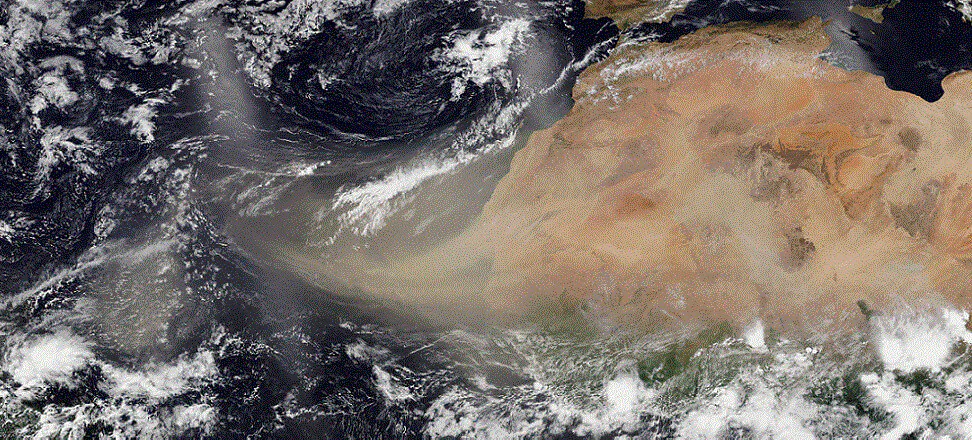Issue 14/2024, News
What does Sahara dust have to do with hurricanes?
The interdependencies that govern the world’s climate still puzzle meteorologists in many ways. Only now have they discovered correlations between dust from the Sahara and the course of the hurricane season in North America. Researchers at Stanford University have thus disproved the previous theory of the dominant influence of sea temperature on tropical cyclones. How many more such surprises does the Earth’s atmosphere have in store?
Dust from the Sahara in the role of conductor
On July 24 of this year, a study was published in Science Advances that has left many climatologists perplexed. Until now, it was thought that the intensity of hurricanes in North America was mainly influenced by the temperature at the ocean surface or the level of moisture in the atmosphere. A team of scientists led by prof. Yuan Wang of Stanford, however, proved that the main director of storms may be dust from over the Sahara. How is this possible?
Dust particles rising into the air over the world’s largest desert are able to travel thousands of kilometers, as we saw in Poland this April. The yellow clouds also reach the Atlantic Ocean, where they facilitate the formation of ice clouds, playing the role of a condensation nucleus and translating into increased precipitation in North America. On the other hand, however, dense dust from over the Sahara obscures the sun and lowers the sea surface temperature, reducing the potential for tropical cyclones to develop – lower temperatures mean less energy for storms.
To better understand the actual impact of dust on weather, Stanford researchers used meteorological data from the past 19 years and developed a machine learning model that could predict hurricane intensity based on satellite images.
More dust, fewer hurricanes?
Prof. Yang acknowledged that in such a complex climate process, simple, linear relationships cannot be expected. From the mathematical and physical analyses conducted by his team, it appears that the key factor is the so-called. optical depth of dust clouds. This parameter describes how much light penetrates a given medium, in this case a dust plume. What did it turn out to be?
When the optical depth of dust is between 0.03 and 0.06, an intensification of rainfall is observed over North America. An increase in dust concentration, on the other hand, is associated with a significant weakening of rainfall and hurricane activity. Graphical representation of the dependence of dust concentration from over the Sahara takes the form of a boomerang-shaped function.
What else is worth knowing about Sahara dust?
The world’s largest desert covers 9.2 million square kilometers and continues to expand – by as much as 10 percent over the past century. According to various sources, between 25 and 30 percent. of its surface is covered by sand, which consists of larger grains and small dust particles. Under the influence of storms passing over North Africa, the latter rises into the air. According to NASA measurements, every year, 182 million tons of dust from over the Sahara move beyond the border of the desert – if we loaded it into trucks, we would get more than 689,000. filled vehicles.
Some of the airborne dust falls to the ground with the rain. The rest, however, travels on and on, even reaching South America. The repercussions of this phenomenon are wide-ranging and extend beyond the US hurricane season. Among the most interesting are:
- Fertilizing the Amazon jungle – dust carries minerals, including large amounts of phosphorus, which the Amazon soil often lacks due to water leaching. African dust clouds reach over the jungle, carrying with them 22,000 tons of phosphorus fertilizer per year. Similar effects are observed in marine ecosystems.
- Meteorologists get it wrong – when Saharan dust appears over Europe weather forecasts are more likely to go wrong, according to a study published in the March issue of the Quaterly Journal of the Royal Meteorogical Society. The inaccuracies relate in particular to cloud cover and surface radiation levels.
- Worse air quality – increased intensity of dust storms from over the Sahara, this year has led to a marked periodic deterioration in air quality over the Iberian Peninsula and parts of France and Germany, according to an analysis by the European Climate Change Service Copernicus. Copernicus Climate Change Service. This is a clear threat to public health and a likely cause of increased mortality.
We should add that, according to NASA, the amounts of dust from the Sahara will decrease in the next decades (by up to 30 percent in 20-50 years) as a result of warming seas and less wind activity. On the one hand, this will improve air quality in many countries; on the other, it could mean increased hurricane activity and an imbalance of many ecosystems accustomed to receiving airborne fertilizer from Africa.
Photo. main: NOAA-20 satellite/NOAA

 Polski
Polski







